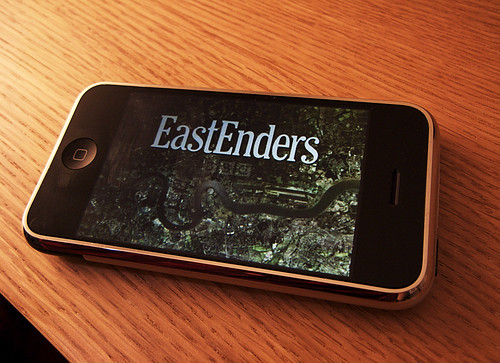Happy New Year! Firstly, a little apology – I put a note at the top of my last blog post saying that I’d explain my use of the terms ‘Internet’ and ‘Web’ soon – I did in fact write a post – but somewhere along the line it never made it out into the wild world. So for that, sorry – but the gist of it was that perhaps I should have used the term ‘Internet’ to refer to the underlying infrastructure network, and the ‘Web’ to refer to the network of information that can be built on top of this.
And now on to the main topic for today. I’ve talked previously about how we could/should be using the Web to provide representations of the narratives we currently tell via radio and television. I said that whilst on-demand services such as iPlayer have had great success, and have certainly improved the consumption of media, they’re not really game-changers, in that they are an attempt to replicate the form of a linear medium within a non-linear medium. As such, although they benefit from the latent abilities of the Internet (speed, distribution, on-demand), they do not take full advantage of the Web. These are still TV or Radio ‘adaptions’ of stories, being distributed by the Internet. What we need is the ‘Web’ adaption of the same story.
I’ve been working over the past month or so on a prototype that will explore these possibilities. At first glance, it seems to be very similar to Wikipedia, in that there are pages for characters, places, events, and links between them. The audience can undertake similar journeys to that of a visitor to Wikipedia – i.e. non-linear, explorative journeys – things which people are already doing (for instance when they say they got ‘lost’ on Wikipedia – in a positive sense!). However, what is different is that these URIs, and the HTML representations of their subjects, are connected directly in the same way as the story itself is being told. Thus, a collection of these URIs, joined together through hyperlinks, can be seen as a small web, or constellation, representing the story itself – a Web adaption – which allows the audience to explore the story from all angles, and gain new perspectives.
For a while now, I’ve been thinking of how the mainstream user will benefit from all this. I think the effect will be fairly subtle at first, and I was imagining two ways of experiencing the story – firstly by hopping from URI to URI and being immersed in the ‘world’ of that thing, and secondly, by taking a step back and examining the web of connections between things, and travelling through this web along a particular path – the act of telling the story. The latter, I imagined, would be through the form of some fairly standard ‘dots and lines’ visualisation, but at the back of my mind, I wasn’t satisfied with this. Co-incidently, I then saw Avatar in 3D at the cinema. Personally, I felt pretty let down by the paucity of imagination shown in the storytelling, but I had to admit that the 3D effect was intriguing. Perhaps, rather than visualising the links through a limited, 2D ‘dots and lines’ diagram, the audience could gain a greater understanding by viewing the story’s Web in 3D, allowing them to see all sides of it.
This is still a possibility, though again I’m very aware of the lack of availability of devices and technologies in the consumer market which support 3D. That, of course, may change, but I wondered whether there were other ways of improving the experience. I was worried that without this, it would just seem, to the general audience, like a replication of Wikipedia (albeit containing information that neither Wikipedia nor fan-wikis hold in such a structured, clickable manner).
And then I considered the ideas of convergence and Augmented Reality – essentially reminding myself that the Internet and the Web, and our interaction with it, need not be restricted to the browser. The Web is, at its heart, merely the highly structured data store – on top of which we can build user interfaces across virtually any connected platform. So, I started to think about mobile and TV viewing. When I’m watching drama, or sport, or the news, I often want to know more – why something is important, what someone is referring to, more about a player, what’s the bigger picture etc. At present, the content is communicated to me via the screen, I interpret it, and then have to go off on my own search to find out more. When doing so, I have to begin again from scratch, communicating the same content (or a near approximation of it) with a computer connected to the Web. What if the content presented to me on screen also had the underlying semantic structures that meant it could do the communication with the Web?
The simplest form of this would be on a mobile device, where, whilst watching the programme (and indeed at any other time), you would navigate to a portal which can guide you to the correct URI contained within the narrative structure – this could take the form of a search engine, or a listing – that way, I could search for ‘Jack Bauer’ and be taken straight into the ‘world’ of 24 – or, more powerfully, if I witnessed an important event happening on screen, I could click the relevant link in the portal, and see other events that have led up to this, more information etc.
But there’s an even more advanced version of this, which I strongly believe could be prototyped and developed pretty quickly. There are technologies available which can take a drama script, and output RDF triples, creating Web structures which represent every element of the narrative, down to the words. These can also be enhanced by matching the triples to timing information within a media representation – so, for instance, identifying that an event happens at 20 minutes into this particular version of the episode, but 15 minutes into another version.
Couple this with the growing links between the consumption of media and the Internet – TV over IP, such as BT Vision, or even on-demand services such as iPlayer. The media is being streamed to the audience – but this is potentially a two way channel – and if we have all the information about the narrative structure and timings for the programme available on the web, then the user can access that wealth of information whilst they are watching – either directly onto the screen, or on a supplementary mobile device.
Just think of what this means for drama, for starters. The ‘flashback’ device in storytelling, essentially used to give the audience a reminder of previous events, so that they can greater enjoy the current story, no longer needs to be incorporated into the linear representation of the story – because as the story is produced, it is connected on the Web to all previous parts of the story. Thus, if the audience wishes to learn more about something, or get a reminder of previous events, they can access them. If you were watching a programme, you could pause it, or activate your mobile device – the playback device would know the timing information of the audience’s action, and could query the Web to find the relevant URIs of information, and present the knowledge found there, back to the user. For instance, if a reference was made on-screen to a past event, rather than the production team having to add in a flashback sequence, the audience could activate the communication at the point of reference, and be presented with the original clip of that event happening. Taken further, this then starts to really break down the linearly-imposed walls between ‘episodes’ of programmes – which are, of course, relics of the original linear nature of television – and instead presents the audience with something much more suited to their own mental models of the narrative they are consuming. In the end, it wouldn’t really matter what episode you were watching – you could be freely exploring the whole universe of narrative, surfing between clip and clip, consuming the story in the order you prefer. Obviously it’s not something you’d want to be doing constantly, but it brings the freedom of the Web to the self-imposed closed structure of the television – and opens up whole new ways of experiencing the stories we tell.
As I mentioned, these are only fresh ideas being formed as we speak, so I’m sure the solution isn’t completely straightforward, but it really does seem that all the various puzzle pieces exist, they just need to be brought together – and the potential could be huge.





